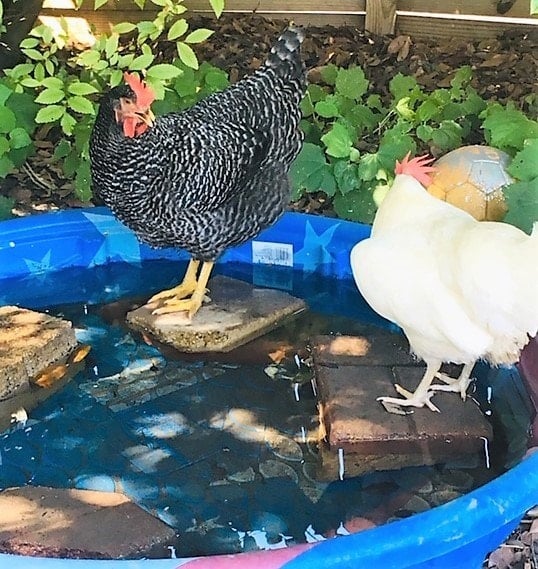How to Keep Chickens Cool in the Summer: A Comprehensive Guide
Raising chickens can be a rewarding experience, but it comes with its challenges, especially during the hot summer months. Chickens are susceptible to heat stress, which can affect their health and productivity. This guide will provide you with effective strategies to keep your chickens cool during the summer, ensuring they remain healthy and productive.
Understanding Chickens and Heat Stress
Chickens are warm-blooded animals, but they do not have sweat glands like humans do. Instead, they rely on other methods to regulate their body temperature, making them vulnerable to heat stress during hot weather.
How Chickens Regulate Body Temperature
Chickens maintain their body temperature through:
- Panting: They open their beaks and breathe rapidly to release heat.
- Wing Spreading: Chickens may spread their wings away from their bodies to allow heat to escape.
- Seeking Shade: They instinctively look for cooler areas when temperatures rise.
Understanding these behaviors is essential for providing an environment that minimizes heat stress.
Signs of Heat Stress in Chickens
Recognizing the signs of heat stress early can help you take immediate action:
- Panting: Rapid breathing with an open mouth.
- Lethargy: Reduced activity levels and reluctance to move.
- Decreased Feed Intake: A noticeable drop in food consumption.
- Drooping Wings: Wings hanging down instead of being held close to the body.
- Increased Water Consumption: Drinking more water than usual.
If you notice these signs, it’s crucial to implement cooling strategies promptly.
Essential Tips for Keeping Chickens Cool
Here are some effective methods to help keep your chickens cool during the summer months:
1. Provide Adequate Shade
Creating shaded areas in your chicken coop and run is essential:
- Install Shade Cloths: Use shade cloths or tarps over the coop and run to block direct sunlight.
- Plant Trees or Shrubs: Natural shade from trees can provide a cooler environment.
2. Ensure Fresh Water Supply
Access to clean, cool water is vital for hydration:
- Multiple Waterers: Provide several water sources to ensure all chickens have access.
- Keep Water Cool: Place waterers in shaded areas and consider using insulated containers.
3. Improve Ventilation
Proper ventilation reduces humidity and allows hot air to escape:
- Open Windows and Vents: Ensure all openings are unobstructed to promote airflow.
- Install Fans: Use small fans to circulate air within the coop.
4. Use Misters or Fans
Misting systems can significantly lower temperatures:
- Misting Systems: Install misters that spray fine water droplets into the air, creating a cooling effect.
- Fans: Position fans near waterers or feeding areas to help cool chickens as they eat or drink.
5. Adjust Feeding Schedule
Feeding chickens during cooler parts of the day can help reduce heat stress:
- Morning Feeding: Offer feed early in the morning when temperatures are lower.
- Evening Feeding: Alternatively, feed them in the evening when it’s cooler.
6. Create a Dust Bath Area
Dust baths help chickens regulate their body temperature and maintain feather health:
- Provide Dust Bath Materials: Use sand, dirt, or wood ash in a designated area for dust bathing.
7. Monitor Health Regularly
Regular health checks can help you catch any issues early:
- Check for Signs of Stress: Monitor your chickens daily for signs of heat stress or illness.
Special Considerations for Different Breeds
Some chicken breeds are more susceptible to heat stress than others:
Heat-Sensitive Breeds
Breeds with large combs and wattles (e.g., Leghorns) tend to be more vulnerable due to their inability to dissipate heat effectively.
Hardy Breeds
Breeds like Rhode Island Reds and Orpingtons are generally more resilient in hot weather due to their thicker feathers and hardiness.
Summary Table of Cooling Strategies
| Strategy | Description |
|---|---|
| Provide Adequate Shade | Use shade cloths, trees, or tarps to block sunlight |
| Ensure Fresh Water Supply | Provide multiple water sources; keep them cool |
| Improve Ventilation | Open windows/vents; install fans for air circulation |
| Use Misters or Fans | Install misters; use fans near waterers |
| Adjust Feeding Schedule | Feed during cooler times (morning/evening) |
| Create a Dust Bath Area | Provide materials like sand or dirt for dust bathing |
| Monitor Health Regularly | Check daily for signs of heat stress |
FAQ Section
Q1: What temperature is too hot for chickens?
Chickens can start experiencing heat stress at temperatures above 75°F (24°C). It’s crucial to monitor them closely as temperatures rise above this threshold.
Q2: How much water should I provide per chicken?
Chickens typically require about 500 milliliters (or approximately 17 ounces) of fresh water per bird per day, which may increase during hot weather.
Q3: Can I use ice in their water?
Yes! You can freeze water in containers and place them in the waterers to keep the water cool throughout the day.
Q4: Do all chicken breeds handle heat equally?
No, some breeds are more susceptible to heat stress than others. Breeds with larger combs and wattles tend to struggle more in high temperatures.
Q5: What should I do if my chickens show signs of severe heat stress?
If you notice severe signs such as lethargy or excessive panting, immediately move your chickens to a cooler area, provide plenty of fresh water, and consider using misters or fans.
Conclusion
Keeping chickens cool during the summer months is essential for their health and productivity. By implementing effective cooling strategies such as providing shade, ensuring hydration, improving ventilation, using misters or fans, adjusting feeding schedules, creating dust baths, and monitoring health regularly, you can help your flock thrive even in high temperatures.For more information on poultry care and management practices, consider visiting Poultry – Wikipedia.



